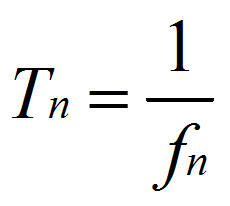Acceleration and Deceleration Pulses Calculation
The HMISCU calculates the time between pulses during acceleration and deceleration in the cases of:
oPTOMoveVelocity
oPTOMoveRelative
oPTOStop
oDec. Fast Stop
PTOMoveRelative: Acceleration Pulses Calculation
To calculate the period Tn (in seconds) between pulses during acceleration, the frequency fn is rounded up to the nearest integer for that pulse period is calculated:


a acceleration rate in Hz/s
This diagram depicts when Frequency Start = 0 Hz:

n is a positive integer representing the nth pulse period from the start of the acceleration phase.
PTOMoveRelative: Deceleration Pulses Calculation
To calculate the period Tn (in seconds) between pulses during deceleration, the frequency fn is rounded up to the nearest integer for that pulse period is calculated:


d deceleration rate in Hz/s
This diagram depicts when Frequency Start = 0 Hz:

n is a positive integer representing the nth pulse period from the end of the deceleration phase.
PTOMoveRelative: Determining Acceleration Rate (a) and Deceleration Rate (d)
If the units of Acc./Dec. Unit is set to ms, the acceleration rate in Hz/s is:

If the units of Acc./Dec. Unit are set to ms, the deceleration rate in Hz/s is:

The Target Frequency is value from the Velocity input pin from PTOMoveRelative function block.
The acceleration/deceleration time is the Acceleration/Deceleration input pins from the PTOMoveRelative function block.
If the units of Acc./Dec. Unit is set to Hz/ms, the acceleration/deceleration rate are that of the Acceleration/Deceleration pins on the PTOMoveRelative function block.
PTOMoveVelocity: Acceleration and Deceleration Pulses Calculation
If the units of Acc./Dec. Unit is set to ms, the acceleration rate from a motionless axis (current frequency = 0 Hz) in Hz/s is:

When a new motion command is issued when the axis is currently in motion from a previous motion command:
oif the new velocity is greater than the previous velocity and if the units of Acc./Dec. Unit is set to ms, the acceleration rate from an axis currently in motion from a previous motion command to a in Hz/s is:

oif the new velocity is less than the previous velocity and if the units of Acc./Dec. Unit is set to ms, the deceleration rate from an axis currently in motion from a previous motion command in Hz/s is:

Where:
Target Frequency is value from the Velocity input pin from PTOMoveVelocity function block for a motion command that accelerates from a motionless axis (0 Hz).
Target Frequency1 is the current constant velocity of the axis from a previous motion command.
Target Frequency2 is the velocity target for the next motion command.
The acceleration/deceleration time is the Acceleration/Deceleration input pins from the PTOMoveVelocity function block.
If the units of Acc./Dec. Unit is set to Hz/ms, the acceleration/deceleration rate are that of the Acceleration/Deceleration pins on the PTOMoveVelocity function block.
PTOStop: Determining Deceleration Rate (d)
If the units of Acc./Dec. Unit are set to ms, the deceleration rate in Hz/s is:

The Target Frequency is from the Velocity input pin from PTOMoveRelative or PTOMoveVelocity function block.
The deceleration time is the Deceleration input pin from the PTOStop function block.
If the units of Acc./Dec. Unit are set to Hz/ms, the deceleration rate is that of the Deceleration pin on the PTOStop function block.
If the units of Acc./Dec. Unit are set to ms, the deceleration rate in Hz/s is:

Maximum Frequency and Dec. Fast Stop are set in the PTO configuration user interface (or with PTOSetParam during program operation).
If the units of acceleration/deceleration are set to Hz/ms, the deceleration rate is that of the Dec. Fast Stop rate set in the PTO configuration user interface.
NOTE: The minimum acceleration or deceleration rate is 1000 Hz/s (1 Hz/ms). If the calculated acceleration or deceleration rate is less than 1000 Hz/s, the rate used will be 1000 Hz/s (this case is only possible when Frequency Start or Frequency Stop is predefined to be > 0 Hz).